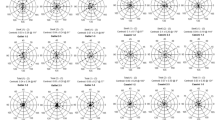Abstract
The purpose of this study was to test the measurements of a multifunctional device, the NIDEK OPD-Scan III in terms of repeatability and agreement with retinoscopy and Pentacam in cases with emmetropia, ametropia, and KCN (grade 1–3). We enrolled 170 eyes (40 in each group of emmetropia and ametropia, and 90 in the 3 KCN subgroups). Acquisitions were done twice by a single technician to check the intra class correlation, repeatability index, and precision. To assess agreement, we compared OPD-Scan III with retinoscopy and Pentacam results by two blinded technicians. All device functions had acceptable precision in groups with emmetropia, ametropia, and KCN1, except spherical error in ammetropics (0.97 D). In KCN2, repeatability was acceptable with the refractive function, topography, and ocular aberrations but was more than 1.0 D for corneal aberrations. In KCN3, repeatability was low for the refractive function and corneal spherical aberration. Refractive data were not convertible to those obtained by retinoscopy in any group. OPD-Scan III keratometry data were interchangeable with Pentacam counterparts in emmetropes, ammetropes, and KCN1. In KCN2, the OPD-Scan III—Pentacam agreement for Kmax was 0.71 D, and there was 1.25 D difference in Kmin. No OPD-Scan III—Pentacam agreement was observed in KCN3. OPD- Scan III is a multifunctional device with acceptable repeatability in emmetropic, ammetropic, and KCN cases. Its measurements of corneal curvature and ocular aberrations are better than other functions. In cases with high degrees of refractive error and corneal irregularities, device repeatability and agreement with Pentacam is decreased.
Similar content being viewed by others
References
Mehravaran S, Asgari S, Bigdeli S, Shahnazi A, Hashemi H (2014) Keratometry with five different techniques: a study of device repeatability and inter-device agreement. Int Ophthalmol 34:869–875
Jasvinder S, Khang TF, Sarinder KK, Loo VP, Subrayan V (2011) Agreement analysis of LENSTAR with other techniques of biometry. Eye (Lond) 25:717–724
Milla M, Pinero DP, Amparo F, Alio JL (2011) Pachymetric measurements with a new Scheimpflug photography-based system: intraobserver repeatability and agreement with optical coherence tomography pachymetry. J Cataract Refract Surg 37:310–316
Savini G, Barboni P, Carbonelli M, Hoffer KJ (2009) Agreement between Pentacam and videokeratography in corneal power assessment. J Refract Surg 25:534–538
Hashemi H, Asgari S, Miraftab M, Emamian MH, Shariati M, Fotouhi A (2014) Agreement study of keratometric values measured by Biograph/LENSTAR, auto-kerato-refractometer and Pentacam: decision for IOL calculation. Clin Exp Optom 97:450–455
Eye & Health care NIDEK CO. LTD (2012) Products: Refractive power/corneal analyzer OPD-Scan lll. Available at: http://www.nidek-intl.com/products/diagnosis/opd-scan3.html. Accessed 26 Aug 2014
Kanellopoulos AJ, Asimellis G (2013) Revisiting keratoconus diagnosis and progression classification based on evaluation of corneal asymmetry indices, derived from Scheimpflug imaging in keratoconic and suspect cases. Clin Ophthalmol 7:1539–1548
Bland JM, Altman DG (1996) Measurement error. BMJ 313:744
Bland JM, Altman DG (1986) Statistical methods for assessing agreement between two methods of clinical measurement. Lancet 1:307–310
McAlinden C, Khadka J, Pesudovs K (2011) Statistical methods for conducting agreement (comparison of clinical tests) and precision (repeatability or reproducibility) studies in optometry and ophthalmology. Ophthalmic Physiol Opt 31:330–338
Portney LGWM (2009) Foundations of clinical research: applications to practice. Pearson/Prentice Hall, UpperSaddle River
McGinnigle S, Naroo SA, Eperjesi F (2014) Evaluation of the auto-refraction function of the Nidek OPD-Scan III. Clin Exp Optom 97:160–163
Gifford P, Swarbrick HA (2012) Repeatability of internal aberrometry with a new simultaneous capture aberrometer/corneal topographer. Optom Vis Sci 89:929–938
Holzer MP, Goebels S, Auffarth GU (2006) Precision of NIDEK OPD-scan measurements. J Refract Surg 22:S1021–S1023
Chan JS, Mandell RB, Burger DS, Fusaro RE (1995) Accuracy of videokeratography for instantaneous radius in keratoconus. Optom Vis Sci 72:793–799
Swart TC (2010) pentacam. In: Agarwal A, Agarwal A, Jacob S (eds) Dr Agarwal’s textbook on corneal topography: including Pentacam and anterior segment OCT, 2nd edn. Jaypee Highlights Medical Publishers Inc., New Delhi, pp 117–136
Khurana AK (2008) Theory and practice of optics and refraction. Elsevier India, Chennai
Sideroudi H, Labiris G, Giarmoulakis A, Bougatsou N, Mikropoulos D, Kozobolis V (2013) Repeatability, reliability and reproducibility of posterior curvature and wavefront aberrations in keratoconic and cross-linked corneas. Clin Exp Optom 96:547–556
Hashemi H, Yekta A, Khabazkhoob M (2015) Effect of keratoconus grades on repeatability of keratometry readings: comparison of 5 devices. J Cataract Refract Surg 41:1065–1072
Acknowledgments
The data in this paper are part of the research for the Ph.D. thesis conducted by the first author (SA) at Noor Ophthalmology Research Center and Tehran University of Medical Sciences. The authors report no conflicts of interest and have no proprietary interest in any of the materials mentioned in this article. This research received no specific grant from any funding agency in the public, commercial, or not-for-profit sectors.
Author information
Authors and Affiliations
Corresponding author
Rights and permissions
About this article
Cite this article
Asgari, S., Hashemi, H., Jafarzadehpur, E. et al. OPD-Scan III: a repeatability and inter-device agreement study of a multifunctional device in emmetropia, ametropia, and keratoconus. Int Ophthalmol 36, 697–705 (2016). https://doi.org/10.1007/s10792-016-0189-4
Received:
Accepted:
Published:
Issue Date:
DOI: https://doi.org/10.1007/s10792-016-0189-4




